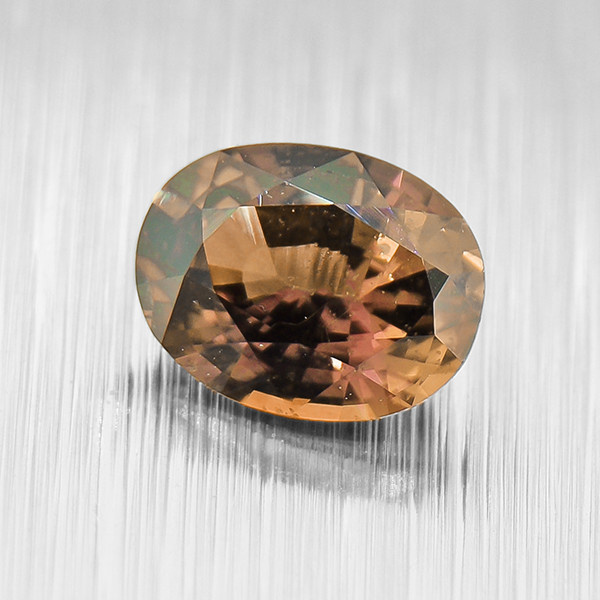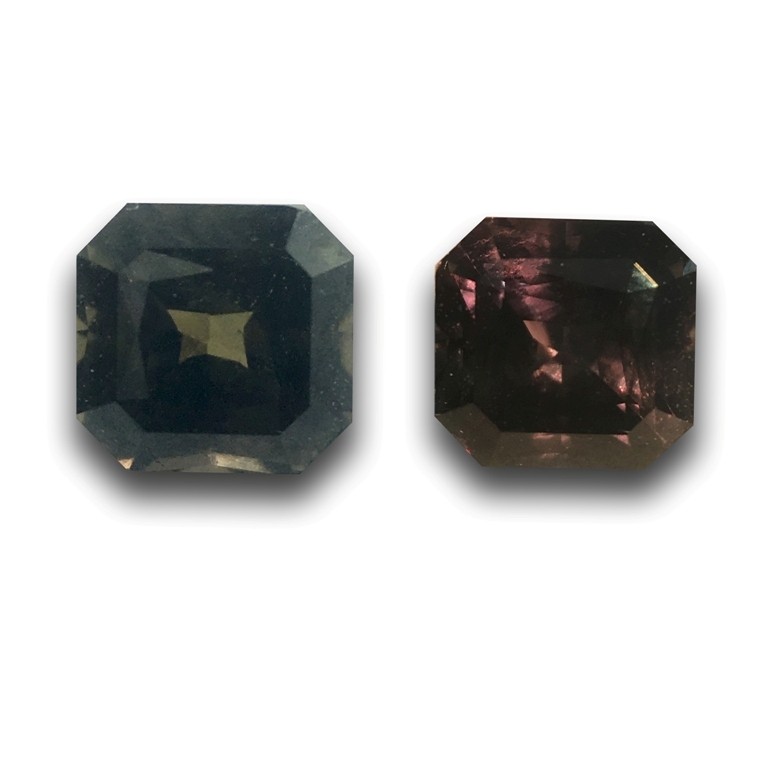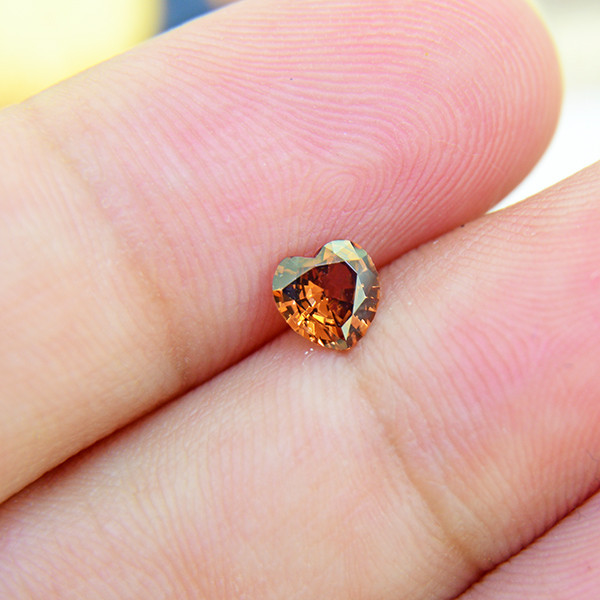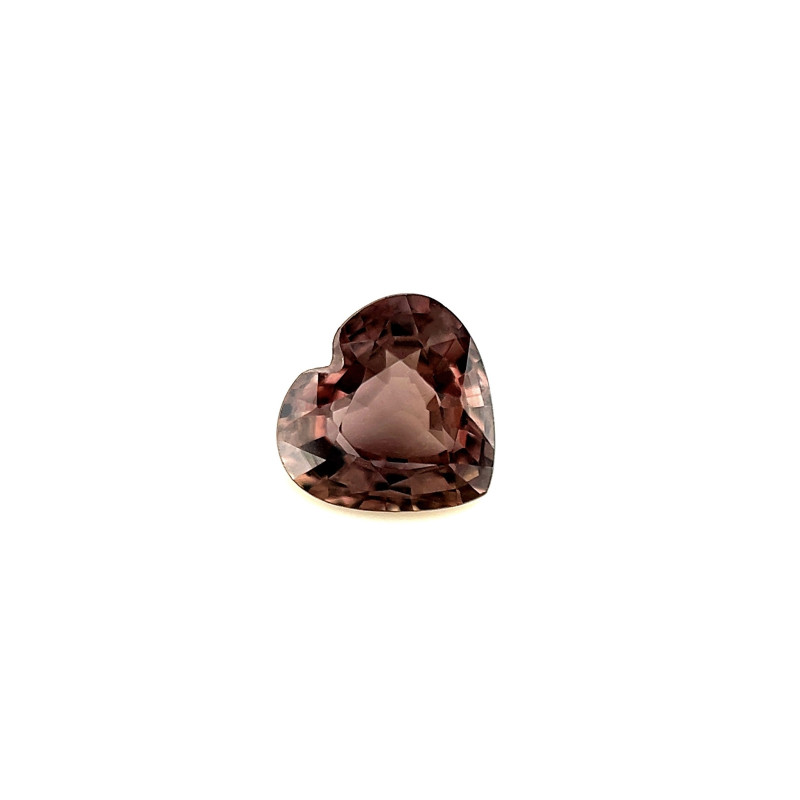
Brown Sapphire Gemstone: Nneɛma, Nkyerɛase, Bo & Mfaso
 Brown sapphire yɛ safir aboɔden abo bi a ɛyɛ dɔte, na ɛyɛ fɛ. Saa safir kɔla yi fii ase gyee din kɛse wɔ nnansa yi mfe mu kaa abo te sɛ chocolate diamond a ɛkɔɔ soro no ho .
Brown sapphire yɛ safir aboɔden abo bi a ɛyɛ dɔte, na ɛyɛ fɛ. Saa safir kɔla yi fii ase gyee din kɛse wɔ nnansa yi mfe mu kaa abo te sɛ chocolate diamond a ɛkɔɔ soro no ho .
Sɛ wote “safire” a, wubetumi ayɛ po ne wim bruu a ɛyɛ nwini ho mfonini ntɛm ara, ebia awɔw bere mu da bi wɔ mpoano. Nanso safir a ɛyɛ bruu de ɔfã a ɛyɛ hyew na ɛyɛ osutɔbere mu de ba aboɔden abo yi so, na ɛkanyan osutɔbere mu nhaban a ɛyɛ crisp ne chocolate a ɛyɛ hyew a ɛyɛ dɛ.
So safir betumi ayɛ bruu wɔ awosu mu? Yiw, wobetumi! Abɔde Maame yɛ safir a ɛyɛ bruu a ɛwɔ kɔla ahorow fi beige a ɛyɛ mmerɛw so kosi chocolate bruu tuntum a ɛyɛ dɛ so, a nnyigyei a ɛwɔ ase pii ne nea wɔadi afra wɔ ntam.
Woasiesie wo ho sɛ wubesua pii? Twɛn bere a yɛrehyɛ wo ma wɔ aboɔden abo a ɛyɛ bruu agyapade, mfaso horow, ne bo, ne nea ɛkeka ho!

Ɛfa Brown Sapphire Abo ho
Sɛ́ safir ahorow no, safir bruu yɛ aboɔden abo a ɛsom bo . Wɔfrɛ safir biara a ɛnyɛ bruu sɛ “fancy” anaa “fancy color” safir, a eyi ka ho. Abodin foforo a wɔde frɛ corundum a ɛyɛ bruu a ɛte sɛ silika ne “adamantine spar.”
Sɛ “kɔla a ɛyɛ fɛ” ne “adamantine spar” da nkyɛn a, dɛn na wɔfrɛ safir a ɛyɛ bruu? Nneɛma a ɛkyerɛkyerɛ aguadi mu (aguadi din) pii wɔ hɔ, efi “cognac” so kosi “champagne” so, nanso akyinnye biara nni ho sɛ nea abu so sen biara ne “ chocolate sapphire .”
Dɛn ne chocolate safir, ankasa? Ɛwom sɛ nkyerɛase a wɔde ma wɔ aguadi ho nsɛmfua te sɛ eyi mu no betumi ayɛ soronko de, nanso adetɔnfo dodow no ara de di dwuma de kyerɛkyerɛ safir a ɛyɛ bruu a ne kɔla yɛ tuntum na ɛyɛ bruu, a ɛnyɛ borɔdɔma pii mu.
Ɛno akyi no, ɛkame ayɛ sɛ wobetumi de “chocolate safir” atɔn safir bruu biara. (Wɔnnyɛ aguadi agyiraehyɛde a ɛwɔ brand-specific quality ne grading ahwehwɛde te sɛ Le Vian Chocolate Diamonds®).
So chocolate safir ho yɛ na? Sɛ́ aboɔden abo no, dabi. Nanso, safir bruu a ɛyɛ aboɔden abo a ɛyɛ sunsuma biara no ho yɛ na kakra.
Aguadi din foforo a wohuu no kɛse wɔ bere a atwam no mu ne “ topaz a ɛsom bo .” Ɛtɔ da bi a wɔde saa din yi di dwuma wɔ safir kɔkɔɔ kosi bruu ho, nanso ne su a ɛdaadaa nkurɔfo no ma edin yi a wɔde di dwuma no tia FCC akwankyerɛ ahorow.
Brown Sapphire Nkyerɛkyerɛmu & Su ahorow
Safir a ɛyɛ bruu wɔ aboɔden abo abusua a ɛyɛ corundum a ɛka rubi ne safir ho no ho. Corundum kronkron yɛ fitaa anaasɛ enni kɔla, enti ɛsɛ sɛ efĩ ahorow wia ne ho ba bere a wɔreyɛ no na ama wɔatumi ayɛ ɔbo no nyankontɔn a ɛwɔ kɔla afoforo.
Dade ne ɛtɔ mmere bi a titanium efĩ ma safir kɔla a ɛyɛ bruu ba. Nokwarem no, nea enti a safir pii yɛ sum saa ne sɛ, titanium pii wom. Nea ɛyɛ anigye no, dade ne titanium nso ma safir bruu yɛ bruu.
Ɛno akyi no, efĩ afoforo betumi ama nne ahorow a ɛwɔ ase aba wɔ safir a ɛyɛ bruu mu, te sɛ chromium kakraa bi a ɛma efĩ a ɛyɛ pink anaa vanadium a ɛfɛm nne a ɛyɛ kɔkɔɔ.
Mpɛn pii no, safir te sɛ eyinom yɛ ahwehwɛ a ɛyɛ tratraa a ɛyɛ prismatic, ɛte sɛ toa, anaa bipyramidal.
Safir bruu a ɛsakra kɔla (a yɛaka ho asɛm kɛse wɔ ase hɔ) no fi dade efĩ te sɛ vanadium ne chromium.
Safire a ɛyɛ bruu a ɛwɔ aboɔden abo ho nsɛm a aka no ni:
Mohs a ɛyɛ den : 9
Kɔla : Bruu ahorow ahorow a ɛyɛ bruu; Nnyigyei a ɛwɔ ase a ebetumi ayɛ pink, kɔkɔɔ, borɔdɔma, kɔkɔɔ, anaa tuntum; Kɔla zoning betumi aba
Ahwehwɛ nhyehyɛe : Ahinanan (afã abiɛsa) .
Luster : Vitreous (ahwehwɛ) kosi sub-adamantine
Transparency : Ɛyɛ nea ɛda adi pefee kosi nea ɛnyɛ nea ɛda adi pefee
Nneɛma a ɛma nneɛma yɛ mmerɛw : 1.76-1.77
Nnipa dodow : 3.98-4.10
Cleavage : Biara nni hɔ
Akisikuru : Conchoidal
Streak : Ɛyɛ fitaa
Luminescence : Ɛtɔ da bi a fluorescence wɔ hɔ - kɔkɔɔ a ɛyɛ mmerɛw wɔ LW-UV & SW-UV (wɔ abɔde & synthetic brown sapphires nyinaa mu); Moderate orange to red wɔ LW-UV & SW-UV ma sapphires a ɛsakra kɔla
Pleochroism : Ɛwɔ hɔ & ɛyɛ den yiye wɔ sapphire a ɛyɛ bruu-akutu mu - borɔdɔma a ɛyɛ bruu kosi ahabammono
Optical effects : Ɛtɔ mmere bi a asterism; Ɛntaa mma sɛ ɛsakra kɔla
Ɛmfa ho sɛ ɛyɛ ahorow ahorow ankasa no, safir a ɛyɛ bruu nso wɔ ahorow kakraa bi.
Brown Sapphire Ahorow ahorow
Safir a ɛyɛ bruu binom wɔ nneɛma soronko a ɛma wotumi hu anaa wotumi hu, na ɛde nneɛma nketewa kakraa bi a ɛda nsow ba:

Brown Sapphire a Ɛsakra Kɔla
Wɔfrɛ safir a ne kɔla sesa a egyina kanea ko a ɛwɔ so (titiriw awia hann ne hann a ɛyɛ hyew) no safir a ɛsakra kɔla . Bere a safir a ɛsakra kɔla nyinaa ho yɛ na no, nea abu so sen biara no dan fi violet so kɔ bruu so.
Ɛtɔ mmere bi a, safir a ɛsakra kɔla tumi sesa fi kɔkɔɔ so kɔ bruu anaa ahabammono so kɔ kɔkɔɔ-biribiri wɔ awia hann ne hann a ɛyɛ hyew mu. Eyinom ho yɛ na na efi Tanzania titiriw.

Nsoromma a Ɛyɛ Brown Safir
Safir pii tumi da aniwa mu adeyɛ bi a wɔfrɛ no asterism adi, baabi a nneɛma bi a wɔde ka ho (diaspore anaa rutile , a ɛyɛ nsɛdi a ɛyɛ pɛ, mpɛn pii no) ma hann a ɛte sɛ nsoromma da adi. Dodow no ara wɔ nsoromma a ɛwɔ hann asia.
Ɛkame ayɛ sɛ abo a ɛyɛ nwonwa yi a wɔfrɛ no “nsoromma safir” no wɔ safir kɔla biara, a nsoromma safir a ɛyɛ bruu no ka ho. Ɛwom sɛ wɔhwehwɛ safir a ɛyɛ bruu a ɛyɛ bruu a ɛyɛ mmerɛw kɛse de, nanso safir a ɛyɛ bruu anaa tuntum a ɛyɛ tuntum a ɛda nsoromma mu hwɛ adi no ma nsonsonoe kɛse ba “nsoromma” a wotumi hu no yiye no so.
Sikakɔkɔɔ a Ɛhyerɛn Safir
Ɛwom sɛ wonnim no yiye de, nanso “sika kɔkɔɔ a ɛhyerɛn” anaa “sika kɔkɔɔ a ɛhyerɛn” safir yɛ Kenya safir a ɛnyɛ hann a ɛyɛ dade a ɛda nsow, a ɛntaa nsi wɔ safir ho. Safir a ɛwɔ ase no betumi ayɛ bruu, kɔkɔɔ, ahabammono, anaa bruu.
Nea ɛhyerɛn no betumi ayɛ kɔbere, sika kɔkɔɔ, anaa kɔbere kɔla, na ɛne safir a ɛyɛ bruu a ɛyɛ tuntum a ɛwɔ ase no bɔ abira fɛfɛɛfɛ. Dade a ɛhyerɛn no fi rutile ne hematite a wɔde ka ho mu .
Edin foforo a wɔde frɛ ɔbo no ne “Zawadi sapphire,” na afe 2010 mu nkutoo na wohuu saa subtype yi.
Sɛ yɛreka abakɔsɛm ho asɛm a, momma yɛnsesa gears mfa nhwɛ brown sapphire bere a atwam ne nea ɛkyerɛ.

Brown Sapphire Nkyerɛase & Abakɔsɛm
Safir a ɛyɛ bruu, te sɛ safir nyinaa, yɛ September awo abo a wɔde di dwuma wɔ amanne kwan so ne Taurus nsoromma mu hwɛ abo. Safir nso yɛ ayeforohyia afe a ɛto so 5, 45, ne 75 ho aboɔden abo a wɔde di dwuma wɔ amanne kwan so.
Sɛ wɔwoo wo wɔ November mu a, wubetumi nso de safir bruu a ne kɔla yɛ cognac asi citrine anaa topaz kɔkɔɔ ananmu sɛ w’awoda bo wɔ November mu .
Wɔ abakɔsɛm nyinaa mu no, safir ayɛ nyansa, nokwaredi, adamfofa, ne ɔsoro ho sɛnkyerɛnne. Wɔn a wɔdɔɔso wɔ nnipa a wɔkorɔn mu no maa wɔne anuonyamfo, adehye, ne dibea nyaa fekubɔ foforo. Safir a ɛyɛ bruu gyina hɔ ma ahoɔden, ahoɔden a wɔde gyina ano, ne ahoɔden a wɔde gyina pintinn pɔtee.
Nsoromma a ɛyɛ bruu safir wɔ wɔn ankasa ntease. Abakɔsɛm mu no, Kristofo anansesɛm bi kyekyeree nsoromma a ɛyɛ hann asia safir kyekyeree gyidi, nkrabea, ne anidaso su pa ahorow ho, na wɔtoo aboɔden abo no din “Nkrabea Abo.”
Ná tetefo nso gye di sɛ safir betumi ayɛ agyan a ɛbɔ wɔn ho ban ne nnuru a wɔde ko tia awuduru anaa nneɛma bɔne afoforo.
Abakɔsɛm
Asɛmfua “safire” no wɔ ntini abien a ebetumi aba sɛ efi ase. Ade biako a ebetumi afi mu ne Tete Hela kasa a wɔfrɛ no sappheiros , a ɛkyerɛ ‘ɔbo bruu.Eyi fa “safire” a ɛka lapis lazuli ne aboɔden abo afoforo a ɛyɛ bruu ho asɛm kosii Mfinimfini Mmere no mu.
Mfiase foforo a ebetumi aba ne Sanskrit kasa mu śanipriya , a ɛkyerɛ “kronkron ma Saturn,” a ɛfa fekubɔ a safir bruu ne Saturn nya wɔ Hindufo nsoromma mu hwɛ mu no ho.
Abodin a wɔde frɛ Kenya sika kɔkɔɔ safir, “Zawadi safir” no fi Swahili asɛmfua bi a ɛkyerɛ “Asase akyɛde” mu.
Wodii kan kyerɛw abodin a akyɛ koraa a wɔde frɛ safir bruu, “adamantine spar,” wɔ aboɔden abo ho nkyerɛwee mu wɔ 1780. Ɛsan puei bio wɔ 1934 de Gems & Gemology .
Safir bruu biako a ɛda nsow ne Raspoli (a wɔsan kyerɛw no Ruspoli, Rospogli, anaa Rospoli).
Raspoli Safir a wɔde yɛ nneɛma
“Raspoli” yɛ safir a ɛyɛ bruu a ɛyɛ mmerɛw a ne kɛse yɛ karat 135, ɛte sɛ lozenge. Saa ɔbo kɛse a ɛyɛ nwonwa yi te Paris mprempren wɔ Abɔde Ho Abakɔsɛm Tete Nneɛma Akorae.
Ɛnyɛ sɛnea wɔkyerɛw ɔbo no nko na ɛsono fibea ahorow, na mmom (nea ɛda nsow kɛse) nea ɛsɛ sɛ safir kura din yi wɔ so ankasa nso.
Ebetumi aba sɛ wonya “Ruspoli” din no fi amanneɛbɔ ahorow a ɛkyerɛ sɛ German ɔheneba bi tɔɔ ɔbo no fii Italiafo atitiriw abusua bi a wɔfrɛ wɔn Ruspolis hɔ no mu. Mfiase foforo a ebetumi aba ne sɛ Italiani ɔheneba bi a wɔfrɛ no Ruspoli tɔn maa ɔbarima bi a afei ɔtɔn maa Ɔhene Louis XIV wɔ 1600 mfe no awiei mu hɔ.
Nanso nsɛm bi ka “Ruspoli” ho asɛm sɛ safir bruu a abakɔsɛm mu no, wɔde frafraa Grand Sapphire a Louis XIV yɛe, safir bruu a ne kɛse yɛ karat 135 saa ara.
Nea eye ne sɛ, safir a ɛyɛ bruu a ɛsa yare no yɛ tẽẽ kɛse.

Brown Sapphire Ayaresa Nneɛma
Te sɛ aboɔden abo nyinaa no, safir a ɛyɛ bruu betumi ayɛ abo a ɛsa yare . Ahwehwɛ no wɔ aboɔden abo a ɛyɛ bruu su a efi awosu mu , na ɛma wonya fam na ɛbɔ ho ban.
Afei nso, brown sapphires are great root chakra stones , kari pɛ wɔ saa ahoɔden mfinimfini yi de wo fapem a ɛyɛ den brɛ wo ma w’ankasa wo nyin.
Nipadua mu Ayaresa
Wɔ honam fam no, mfaso horow a wɔkyerɛ sɛ ɛwɔ safir bruu so no bi ne ɔhaw ahorow a wɔbɛsa wɔ:
Stamina a ɛyɛ den
Asoroben
Wora a ɛyɛ mmerɛw
Nkwammoaa a ɛko tia nyarewa
Mogya a ɛkɔ nipadua no mu
Nkate mu Ayaresa
Ebia ɛnyɛ nwonwa sɛ ade a agye din sen biara a wɔde safire bruu di dwuma ne sɛ wɔbɛhyɛ asase so na wɔde adwene asi nneɛma so. Wɔkyerɛ nso sɛ ahwehwɛ no yi nsusuwii ne dadwen a epira fi hɔ, na ɛde ahomegye, adwene a wɔde si biribi so, ne nyansa si nkate bɔne ananmu.

Brown Sapphire Aboɔden abo Nneɛma a Ɛwɔ Hɔ
Botae a safir a ɛyɛ bruu wɔ no gyina ne kɔla, ne twitwa, sɛnea emu da hɔ, ne mu duru a ɛyɛ carat, ne sɛnea wɔde sa yare no so.
Ahosuo
Safir kɔla a ɛyɛ bruu no gu ahorow wɔ ɛnne, saturation, ne ase. Nnyigyei a ebetumi aba wɔ ase ne kɔkɔɔ, pink, kɔkɔɔ, tuntum, ne borɔdɔma. Nneɛma bi a wɔtaa kyerɛkyerɛ mu ne:
Kyokolate
Cognac a wɔde yɛ aduan
Whisky a wɔde yɛ adwuma
Champagne a wɔde yɛ adwuma
Tawa a wɔde di dwuma
Khaki na ɛyɛ
Cognac bruu sapphires, titiriw, agye din kɛse. Eyinom wɔ kɔla kɔkɔɔ-akutu kosi kɔkɔɔ-biribiri, na kɔla kɔkɔɔ no som bo kɛse.
Nea ɛda nsow ne sɛ, safir ahorow bi a efi Tanzania a wɔakyerɛw so sɛ Padparadscha safir no yɛ kɔkɔɔ-biribiri a pink kakra wɔ mu. Aboɔden abo ho animdefo dodow no ara mfa eyinom nhyɛ Padparadscha safir ankasa mu, nanso ɛda so ara ho yɛ na na ɛsom bo yiye.
Twa
Safir bruu pii wɔ faceted , mpɛn pii no ɛyɛ oval anaa kurukuruwa a wɔtaa yɛ. Ɛsɛ sɛ wotwitwa nsoromma safir a ɛyɛ bruu sɛ cabochons na ama wɔada wɔn aniwa so tumi adi yiye.
Nneɛma afoforo a wɔatwitwa ama aboɔden abo yi bi ne nwene ne nhwiren.
Ɛda adi pefee
Sapphires wɔ Type II kɔla aboɔden abo a emu da hɔ grade , a ɛkyerɛ sɛ wɔhwɛ kwan sɛ wɔde nneɛma nketenkete bi a wotumi hu bɛka ho. Nneɛma a wɔtaa de ka ho ne nneɛma a wɔde ka ho a ɛte sɛ asaawa “silk” te sɛ rutile, a ebetumi ama ayɛ sɛ velvet.
Mpɛn pii no, safir bruu a wɔde ka ho kɛse no bo nyɛ den, ɛwom sɛ ɛnyɛ agudeyɛfo nyinaa na wodi akwankyerɛ yi akyi de. Nanso, ebia wobenya adetɔfo anigye kakra, efisɛ nneɛma pii a wɔde ka ho te sɛ nnade betumi ama ɔbo no ayɛ te sɛ quartz a wusiw wom a wɔayɛ no rutilated.
Nea ɛka ho wɔ mmara a ɛfa nneɛma a wɔde ka ho pii-a ne bo sua no ho ne nsoromma a ɛyɛ bruu a wɔde safir ayɛ, efisɛ nea wɔde ka ho no ma nsoromma mu hwɛ, a ɛyɛ ade a ɛsom bo a ɛma wohu ade.
Carat Mu duru & Ne Kɛse
Ɛwom sɛ akɛse bi wɔ hɔ de, nanso safir aboɔden abo a ɛyɛ bruu dodow no ara yɛ carat 4 anaa nea ennu saa. Abo akɛse bɛma wɔanya nneɛma bo a ɛkorɔn.
Ayaresa & Nneɛma a Wɔde Yɛ Nneɛma
Wɔde ɔhyew na ɛyɛ safir dodow no ara, enti ɔhyew a wɔde yɛ adwuma no mma ne bo so ntew kɛse.
Nanso mpɛn pii no, safir bruu a ɛyɛ tuntum dodo no bɛhyerɛn, na ebetumi ama aboɔden abo no bo akɔ fam. Wobetumi de mframa a ano yɛ den ahyɛ safir a wɔannoa a ɛyɛ bruu a emu yɛ hare mu ma ayɛ kɔkɔɔ anaa kɔkɔɔ-kɔla a ɛyɛ borɔdɔma a wɔpɛ kɛse.
Safir a ɛyɛ bruu a wɔayɛ no ntaa mma dodo, nanso wɔtaa yɛ nsoromma safir. Ɛsɛ sɛ nea ɔtɔn no da aboɔden abo a wɔayɛ no adi bere nyinaa sɛ ɛte saa, efisɛ ɛrensom bo pii nsen abɔde mu de.

Brown Sapphire Formation & Nneɛma a Wɔde Yɛ Adwuma
Corundum abo te sɛ safir a ɛyɛ ahabammono na ɛba wɔ abotan a ɛyɛ metamorphic anaa igneous mu.
Wɔ abotan a ogya wom mu no, ɔbo no yɛ ahwehwɛ bere a ɔbotan no dwo fi magma mu no. Mmere a ɛma onwini kyɛ no ma ahwehwɛ akɛse ba. Ɛsɛ sɛ ɔbotan a ɛyɛ ogya no yɛ nea aluminium pii wom na silica nni mu, te sɛ nepheline syenites.
Wɔ abotan a ɛsakra mu no, ahwehwɛ no taa ba bere a tete po ase dan fi nsu a ɛyɛ hyew a aluminium pii wom mu no.
Mpɛn pii no, abotan a ɛkura safir no sɛe, na ɛma nsu tumi de aboɔden abo no kɔ mmeae a nsu a ɛtɔ te sɛ nsubɔnten.
Mmeae a Wɔtu Tuo
Bere a wotu safir bruu a ɛyɛ mfiridwuma mu de wɔ wiase nyinaa no, safir bruu a ɛyɛ aboɔden abo titiriw fi:
Australia
Madagascar
Sri Lanka na ɛwɔ hɔ
Tanzania na ɛwɔ hɔ
Thailand
Sɛ yɛhwɛ ne bo a, so safir tuntum (te sɛ safir a ɛyɛ bruu) bo yɛ den? Dabi, nanso ɛsono nneɛma bo.

Brown Sapphire Bo & Ne Bo
Nea eye ne sɛ, safir aboɔden abo a ɛyɛ bruu dodow no ara yɛ nea ɛho nhia pii sen safir kɔla afoforo, titiriw bruu anaa Padparadscha safir. Ɛno akyi no, brown sapphires da so ara tumi soa bo a ɛkorɔn — ne nyinaa gyina ne su so.
Faceted brown sapphire bo a carat biara fi ase bɛyɛ $30 wɔ carat biara mu na ebetumi adu bɛyɛ $700 wɔ carat biara mu anaa nea ɛboro saa.
Safir bruu a ɛsakra kɔla (a ɛwɔ afã horow) no gye dɔla 120 kosi 3,000 wɔ carat biara mu bere a ɛyɛ carat 0.5 kosi 1, ne dɔla 300 kosi 5,000 wɔ carat biara mu bere a ɛyɛ carat 1 kosi 7 no.
Brown star sapphire cabochons yɛ nea ne bo yɛ den koraa a ne bo yɛ dɔla 13 kosi 30 pɛ wɔ carat biara mu.
Brown Sapphire Hwɛ ne Nsiesiei
Ansa na yɛbɛwie no, yɛbɛkɔ akɔhwɛ aboɔden abo a wɔhwɛ so yiye so . Nea eye ne sɛ, safir kyɛ, enti sɛ wobɛhwɛ so a, ɛyɛ mmerɛw yiye.
Safir a ɛsɛ sɛ yɛhwɛ yiye wɔ ho kɛse nkutoo ne nea ɛka ho kɛse, abubu, anaasɛ mframa a ano yɛ den wom. Ma saa ahorow yi ntwe wo ho mfi mfiri a wɔde tew nneɛma ho ne nnuru a ano yɛ den ho.
Sɛ wopɛ sɛ wohohoro safir a ɛyɛ bruu ho a, fa brɔs a ɛyɛ mmerɛw, samina a emu nyɛ den, ne nsu a ɛyɛ hyew di dwuma. Fa sie wɔ ɔkwan soronko so fi aboɔden abo afoforo ho.

Woasiesie Wo Ho sɛ Wobɛte Mfaso a Ɛwɔ Brown Sapphire So no nka?
Sapphires wɔ abakɔsɛm a ɛkyerɛ sɛ wɔne ahemfo ne bougie mpanyimfo a wɔkorɔn wɔ fekubɔ, nanso safir bruu ma wonya ɔkwan foforo a ɛyɛ fɛ ma nnipa a wɔba fam kɛse. Plus, ɛyɛ kari pɛ na stabilizing mfaso bɛma wo ate nka zen wɔ bere tiaa bi mu.
搜尋Gemstone Encyclopedia
相關拍賣
相關文章
Gem Rock Auctions wɔ Certified Gemstones a ɛso sen biara wɔ intanɛt so no mu biako. Hwehwɛ aboɔden abo sɔhwɛ afiri a wɔapene so yi mu.
24th Jul 2018
Hackmanite yɛ sodalite aboɔden abo a ɛyɛ pink kosi violet a wonim no sɛ ne kɔla-sesa ne hann soronko. Sua nea enti a hackmanite yɛ soronko, efi ne su ahorow a ɛntaa nsi so kosi hackmanite agude ahorow a ɛwɔ hɔ so.
28th Mar 2018
Amber yɛ tete dua a wɔatutu fam ayɛ, a mpɛn pii no afifide wɔ mu, a ɛtaa yɛ kɔkɔɔ-akutu na ɛyɛ mfe mpempem pii. Sua amber abakɔsɛm, ne bo, ne ne su!
8th May 2018
最新的文章
Nnua a wɔde asonse a wɔasen a wɔsan frɛ no nhabannuru asonse no yɛ abɔde mu ade a wɔde si asono asonse ananmu, na wotwa fi Amerika Kesee Fam phytelephas nnuadewa mu nnuadewa mu wɔ abrabɔ pa mu. Sua mmɛw asonse ho ade nyinaa wɔ akwankyerɛ yi mu!
15th Jan 2026
Chrysanthemum nhwiren abo yɛ abɔde mu anwonwade a ɛwɔ calcite, celestite, anaa andalusite nhwiren fitaa bi a wɔde asisi limestone tuntum anaa atɛkyɛ abo so.
13th Jan 2026
Rainbow lattice sunstone yɛ feldspar ahorow a ɛwɔ optical nsunsuanso abiɛsa fɛfɛ a efi nneɛma ahorow a wɔde ka ho a ɛwɔ hɔ no mu ba. Ɛyɛ ogya kɔla display ne lattice nsusuwso ma ɛyɛ coletor abohene a wɔntaa nhu!
12th Jan 2026
文章類別
How To's is where you will find helpful articles from gem Rock Auctions on how to cut gemstones, select gemstones and buy gemstones.
9文章





